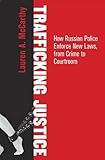Trafficking Justice : How Russian Police Enforce New Laws, from Crime to Courtroom / Lauren A. McCarthy.
Material type: TextPublisher: Ithaca, NY : Cornell University Press, [2016]Copyright date: ©2016Description: 1 online resource (304 p.) : 2 line figures, 21 tables, 5 chartsContent type:
TextPublisher: Ithaca, NY : Cornell University Press, [2016]Copyright date: ©2016Description: 1 online resource (304 p.) : 2 line figures, 21 tables, 5 chartsContent type: - 9781501701375
- Human trafficking -- Law and legislation -- Russia (Federation) -- Criminal provisions
- Human trafficking -- Russia (Federation)
- Law enforcement -- Russia (Federation)
- History
- Legal History & Studies
- Soviet & East European History
- POLITICAL SCIENCE / Law Enforcement
- Russia, police enforcement, law enforcement, legal arsenal, crime, human trafficking, slave labor, Russian legal and judicial institutions, courtroom, prosecution, socio-legal studies, Russian politics
- 360
- online - DeGruyter
| Item type | Current library | Call number | URL | Status | Notes | Barcode | |
|---|---|---|---|---|---|---|---|
 eBook
eBook
|
Biblioteca "Angelicum" Pont. Univ. S.Tommaso d'Aquino Nuvola online | online - DeGruyter (Browse shelf(Opens below)) | Online access | Not for loan (Accesso limitato) | Accesso per gli utenti autorizzati / Access for authorized users | (dgr)9781501701375 |
Frontmatter -- Contents -- List of Figures -- List of Tables -- Preface -- Note on Transliteration -- List of Abbreviations -- Criminal Code Articles Referenced -- Introduction -- 1. History, Trends, and Contours of Human Trafficking in Russia -- 2. The Human Trafficking Laws -- 3. Law Enforcement’s Institutional Machinery and the Criminal Process -- 4. The Identification of Human Trafficking Cases -- 5. The Investigation of Human Trafficking Cases -- 6. Indictment, Trial, and Sentencing -- Conclusion -- Appendix A: Methodology -- Appendix B: Official Russian Law Enforcement Statistics on Human Trafficking Crimes -- Legal Sources -- References -- Index
restricted access online access with authorization star
http://purl.org/coar/access_right/c_16ec
In response to a growing human trafficking problem and domestic and international pressure, human trafficking and the use of slave labor were first criminalized in Russia in 2003. In Trafficking Justice, Lauren A. McCarthy explains why Russian police, prosecutors, and judges have largely ignored this new weapon in their legal arsenal, despite the fact that the law was intended to make it easier to pursue trafficking cases.Using a combination of interview data, participant observation, and an original dataset of more than 5,500 Russian news media articles on human trafficking cases, McCarthy explores how trafficking cases make their way through the criminal justice system, covering multiple forms of the crime—sexual, labor, and child trafficking—over the period 2003–2013. She argues that to understand how law enforcement agencies have dealt with trafficking, it is critical to understand how their "institutional machinery"—the incentives, culture, and structure of their organizations—channels decision-making on human trafficking cases toward a familiar set of routines and practices and away from using the new law. As a result, law enforcement often chooses to charge and prosecute traffickers with related crimes, such as kidnapping or recruitment into prostitution, rather than under the 2003 trafficking law because these other charges are more familiar and easier to bring to a successful resolution. In other words, after ten years of practice, Russian law enforcement has settled on a policy of prosecuting traffickers, not trafficking.
Mode of access: Internet via World Wide Web.
In English.
Description based on online resource; title from PDF title page (publisher's Web site, viewed 26. Apr 2024)


